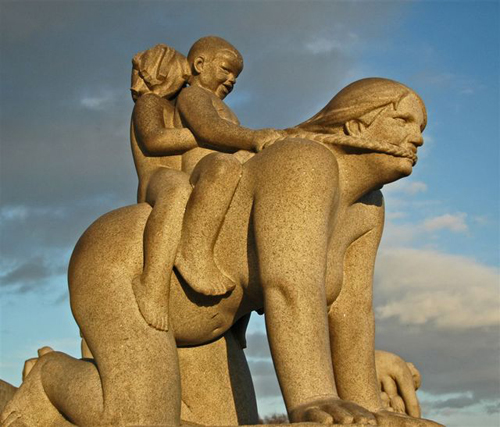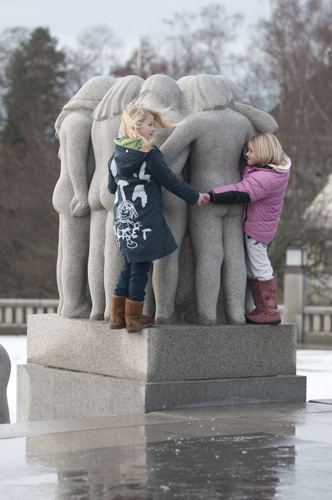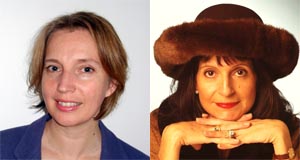
Why have I never been to Norway, I wonder as I view the breathtaking images of this amazing country on Google search. I email my close friend, Norwegian expert and talented architect, Maddy Vigeland, and ask her to share with me a Norwegian view for my new education post.
“A few things come to mind,” Maddy emails back. “In addition to skiing, the fjords — miles and miles of dramatic landscape, salmon/lox, something called lutefisk. Then, folk songs, the bravery of Leif Ericson, the adventures of Thor Heyerdahl and his Kon-Tiki, the sadness of Edvard Munch paintings, the bold and brutal sculptures of Gustav Vigeland, the outrageous integration of landscape with culture in Oslo’s new ballet and opera house by Snohetta architects. Also, Liv Ullman, Sonje Henie, and perhaps the most distinguishing characteristic of all — the general agreement by all Norwegians on the way to live — focused on the quality of life.”
Thank you Maddy Vigeland. I’m hooked, but before I will commit to admitting I’m booked, allow me to share an educational view of Norway from my newer Norwegian friend, Dr. Kirsten Sivesind, distinguished professor in the University of Oslo Faculty of Education.
What kind of educational system will permit a country to have the people skills needed to compete globally?
The latest findings from large scale assessment and knowledge reviews support conclusions that comprehensive education is most successful. In comprehensive education, students acquire knowledge and experience within demographically diverse learning milieus and face a multitude of expectations that are both cultivating and qualifying. Schools where students are grouped according to their abilities and aptitudes, are not as effective.
What is your view of standardized testing?
Standardized testing informs policy makers and practitioners about some of the outcomes of education. However, these tests are limited in scope in measuring the quality of teaching and learning in schools. Some assessment systems, like PISA, measure competencies of large populations, between 4,500 and 10,000 15-16 year old students in each country. These tests might stimulate debates on what is the intellectual capability of students around the globe, but are not so good at measuring the content and methods of teaching.
If generalization is possible, what elements are missing from the current systems, such as critical thinking or other dimensions of human interest and intelligence?
The OECD studies concentrate on the human competencies that are needed in a learning society. This might lead to an orientation to productive learning and performance. However, individual capacity as well as communication is also dependent on receptive skills, which develop through understanding, interpretation and reflection. These skills are not easily measured, but still are essential to become an educated citizen.

What can be done to better address the emotional well-being and intellectual potential of the individual, which appear to be suffering under the current system?
The overall charge of school leaders is to promote school systems which are based on core values like human dignity and respect. This means to stress responsibility rather than accountability and form assessment systems according to overall aims of schooling. It is important that the school system stands on “two legs”: on a well designed curriculum and assessment for learning. For the moment, policy makers have been most concerned about one leg, to create expectations about performance through assessment and accountability systems. They forget that a well-working system depends on good structures, framed by systemic reform and the curriculum.
In Norway, there is a tradition to formulate national curriculum guidelines which are broad based, yet provide a framework for what schooling is about. The guidelines are focused on central aims and subject matter which presuppose thoughtful teaching to be accomplished well. This approach is deliberative in character and guarantees that teaching manuals and prescriptions, whether they be scientific or political, are adjusted to deliberative practices in schools. Emphasis on deliberation will address both emotional well-being and the intellectual potential of the individual.
From a larger perspective, does your country’s definition of educational excellence take into account the quality of life of individuals and of a society, including its artistic and cultural achievements?
The most prominent example of this approach is the Finish educational system. In Finland, a new national curriculum will be implemented in a few years, giving priority to aesthetic subjects. The curriculum is comprehensive, yet students in Finland perform very well in large scale assessment, such as PISA, so a comprehensive curriculum might stimulate good results/outcomes. The General Curriculum in Norway describes a comprehensive curriculum as well and the integrated human being as one that is both cultivated and qualified. Here the tradition is to guarantee not only good results on national tests, but also a school system where students enjoy themselves and experience a good learning environment. I think joy and hard work must go hand in hand.
World Wisdom from Norway
Standardized tests do not measure the quality of teaching or the quality of learning in schools. There is too much emphasis in our education systems on assessment and accountability instead of on curriculum and responsibility. Give teachers more leeway to adapt guidelines to needs of students. The definition of educational excellence in Norway: a comprehensive curriculum, much like in Finland, where the student becomes both cultivated and qualified. Joy and hard work must go hand in hand.

Photos courtesy of Norwegian Embassy.
In The Global Search for Education, join C. M. Rubin and globally renowned thought leaders including Sir Michael Barber (UK), Dr. Leon Botstein (US), Dr. Linda Darling-Hammond (US), Dr. Madhav Chavan (India), Professor Michael Fullan (Canada), Professor Howard Gardner (US), Professor Yvonne Hellman (The Netherlands), Professor Kristin Helstad (Norway), Professor Rose Hipkins (New Zealand), Professor Cornelia Hoogland (Canada), Mme. Chantal Kaufmann (Belgium), Professor Dominique Lafontaine (Belgium), Professor Hugh Lauder (UK), Professor Ben Levin (Canada), Professor Barry McGaw (Australia), Professor R. Natarajan (India), Sridhar Rajagopalan (India), Sir Ken Robinson (UK), Professor Pasi Sahlberg (Finland), Andreas Schleicher (PISA, OECD), Dr. David Shaffer (US), Dr. Kirsten Sivesind (Norway), Chancellor Stephen Spahn (US), Yves Theze (Lycee Francais US), Professor Charles Ungerleider (Canada), Professor Tony Wagner (US), Professor Dylan Wiliam (UK), Professor Theo Wubbels (The Netherlands), Professor Michael Young (UK), and Professor Minxuan Zhang (China) as they explore the big picture education questions that all nations face today. The Global Search for Education Community Page
C. M. Rubin is the author of two widely read online series for which she received a 2011 Upton Sinclair award, “The Global Search for Education” and “How Will We Read?” She is also the author of three bestselling books, including The Real Alice in Wonderland.
Follow C. M. Rubin on Twitter: www.twitter.com/@cmrubinworld

Recent Comments